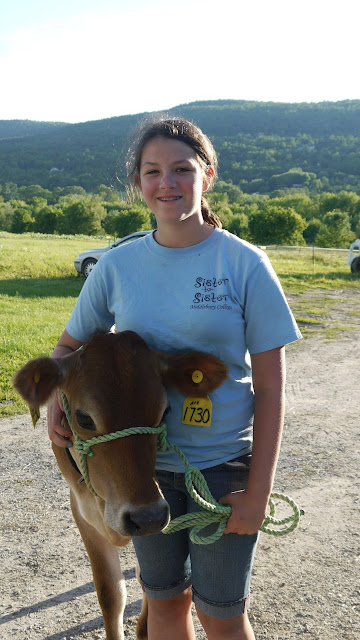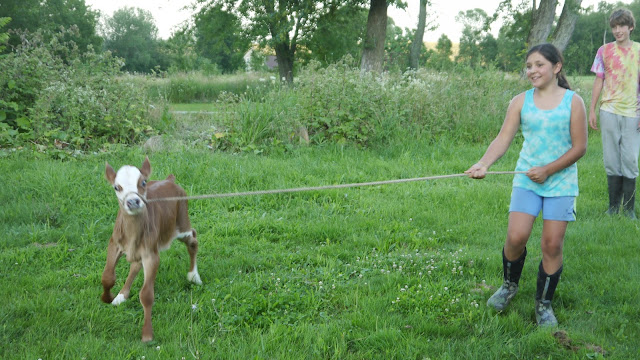 |
| "She's so Jersey." |
New Yorker magazine, 7/29/13
 |
| Two dairy cows, in repose |
Ben, Audrey and Carly, ages 10, 12 and 14, respectively, are committed to 4-H this summer, which for them means working with calves in preparation for showing them at the annual Addison County Field Days that starts this year on Tuesday, August 6. The cows and kids are matched up roughly by size: an older and taller person like Carly will have an older and bigger calf. Carly’s calf, named Autumn, is about one year old. Audrey’s, named Belle, and Ben’s, called Kinsey, are each about nine months old. All the calves are either Holsteins (the black and white ones) or Jerseys (light brown). From the time the 4-H’ers are assigned their calves until the end of Field Days they are responsible for cleaning their cow’s stable, keeping the calf clean, fastening its halters, taking the calf on a lead, and exhibiting in the judging ring. (More on that later.) This is not as easy as you might think.
 |
| Carly with Autumn |
 |
| Audrey bonding with Belle |
In the days before Field Days Carly, Ben and Audrey and the other 4-H’ers made regular trips to the barn where the 4-H cows were boarding, a farm nearby that has good stable facilities but has no cattle of its own. There they had to wash their calf, take it out of the barn on a lead, and practice what they will be doing in the show ring: parading their calves, and lining them up correctly for the judges. The first judging at the fair is about conformation: it is the cow that will be judged (although there is doubtless some contribution made by the manner in which the calf is being led and presented). The ideal calf, future cow, needs to have certain ideal characteristics. To even begin to understand the lingo in judging, it’s necessary to picture the parts of a cow:
Dairy judges have five categories of ideal traits:* “frame,” “dairy character” (yes, character), “body capacity,” “feet and legs,” and “udder.” What’s important in a cow’s frame is that it have a long and wide rump with pin bones (you can see why I put in the chart) that are lower than hip bones, thurls (see above) wide apart, proper proportion of height at withers and hips, front legs placed straight and square, full crops and straight and strong back. And (I love this) the “head should be feminine…” (Maybe it’s those long eyelashes.) As for dairy character, this is about finding evidence of a good future milk supply by looking at the ribs (wide apart), withers (sharp), neck (long, lean), skin (loose, pliable). Then there’s body capacity volumetrically speaking (deep and wide is good). Feet and legs should show good mobility (well-rounded closed toes, straight rear legs wide apart, short and strong pasterns). Lastly, but likely most important, there’s the udder. That, after all, is what it’s all about. Udder traits are depth, teat placement, strong support of the udder cleft, fore and aft udders wide, high and firmly attached (one would hope!), cylindrical teats of uniform size––in short, a balanced and nice looking udder that looks like it would happily hold a lot of milk.
In a calf many of these same characteristics will be in a premature state. Not much of an udder, for example, but lots of potential.
 |
| 4-H'ers getting show ring advice |
The second judging is all about the 4-H’er him/herself. (Calf-showing 4-H’ers are both boys and girls, more or less equally.) “Showmanship” is the byword. This means that the manner, attitude, and care with which they present their animal will be looked at closely. To prep for this all the 4-H’ers have been bonding with their calves for many weeks. At each visit to the barn the young trainers will have led their calves out of the barn, gripping the halters tightly as the calves clump along. Watching eight or nine calves being led in a slow wobbly circle on a pleasant summer afternoon for an hour or so is as soothing an activity as meditation. Things get a bit exciting when one of the larger calves slips her harness and scoots off into the pasture. She kicks up her heels, stops to browse for a moment, then remembers she is free and cantors off again, eluding capture until the lure of grain overwhelms freedom.
 |
| The calves are slowly led around in a circle by their 4-H'ers |
Real dairy life isn’t something I want to know a lot about. It has some unpleasant, even ugly, aspects. Think about eggs, for instance. Where are all the male chickens? Who needs roosters when all you want is eggs? You can think about it, but honestly, I don’t really want to. I also don’t like thinking about what happens to all the male calves. It’s not very different from the chicken issue.
Male calves are obviously pretty useless to a dairy operation. Bulls are harder to handle than cows and how many do you need, really, for reproduction. Some farms don’t need bulls at all. Given that the odds of a cow giving birth to a male is around 50 per cent (barring fooling around with the semen), there are going to be extra male calves. Some of them may be castrated and kept for beef (consider them lucky) and some others sold for veal, a side product of dairy farming I’d never thought about before. The topic of male calves often occasions a rueful expression. It’s not a happy thought.
At the calf barn there is a very young male calf who is adored by everyone, and who is having what will probably be the very best time of his life, the presence of 4-H’ers a bonus for this little guy who looks beguilingly like a fawn. Everyone vies to feed him his bottle, to pet him, and take him out of his stall on a lead and watch him scamper about. (You could imagine having him as a pet.) His mother, Luna, is in an adjacent stall. Another lucky one, she is hand-milked daily. Her milk–unhomogenized, unpasteurized raw milk–fills a refrigerator and is for sale. It tastes delicious. I have watched Ben and Audrey pour the cream from the top of the milk into a smaller jar and shake the jar for maybe ten minutes to make butter. The remaining liquid in which the new butter floats is buttermilk.
 |
| The little male calf romping |
Usually calves are separated from their mothers a couple of days after birth. The cow’s milk, of course, is intended for human, not calves. (Calves will then drink a milk replacement.) Of course the whole business of milk production means cows need to be lactating, and naturally they lactate as a result of giving birth to a calf. Calf production is a constant component of milk production. Pregnancy is nine months, like humans. Milk levels peak at around 40 to 60 days after calving.** As a result the life of a cow is a cycle of pregnancy, birthing, lactation, repeated several times over.
And what of those other (wild) beasts?
Picture two birds, then four, battling in mid-air. Picture one knocking another away from its source of food. Imagine four of them aggressively tearing up and down and sideways. Picture one sitting atop its food source to claim the territory as its own and no one else’s. Know that these are beautiful, tiny hummingbirds. Each day they––however many there are––consume more than two full feeders of nectar.
 |
| The feeder was emptied twice in a single day. |
Below our kitchen windows we have been hearing a loud angry buzzing nearly every day, so loud I imagine the insect making it much be about three feet wide. Last week when Ken squeezed behind the shrub below the kitchen window to clean it he was suddenly set upon by hornets, fortunately escaping with only two bites. A few days later I peered behind the shrub and found a huge hornet nest. He was lucky. The hornets were not. The way to get rid of a nest like that is to wait until dark when all the hornets are back from foraging and spray into the nest opening. Vale, hornet!
 |
| Hidden behind the shrub... |
 |
| ...was this surprise. |
We have often been dive-bombed by swallows, the latest species to make a nest under the roof of our porch. This one was a minor feat of mud and twig engineering, as the next rests on nothing in particular, a mere half-inch of board. The rest is cantilevered. Directly below the nest on the porch deck I found broken eggs on two separate occasions. I was surprised to find two baby swallows looking down at me from the nest above. Did these two toss out their two siblings? I wonder. Yesterday, again directly below the nest, I found the body of a very tiny mouse lying amid bird droppings. Swallows eat flying insects. Could the mouse, being utterly the wrong species, possibly have been an item of rejected food? Or was it a victim of a bird poop bomb?
 |
| The mother swallows looks down at us. Who tossed out the eggs? |
Mysteries.



No comments:
Post a Comment